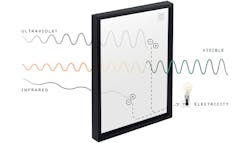Window on the Future: Transparent PV May Soon be Ubiquitous
As a frequent contributor to HPAC Engineering, I am often sent press releases that are relevant to our industry. Recently, I received one that really piqued my interest, since my firm is an owner of two South Florida-based hurricane impact window and door businesses.
The news release, from Ubiquitous Energy in Redwood City, CA, developers and manufacturers of transparent, solar photovoltaic (PV) technology, announced that the company had closed $30 million in new funding, led by Andersen Corporation. Andersen was founded in 1903 and began making window frames in 1908. Today it’s an international window and door manufacturer with billions of dollars in sales, and its investment in Ubiquitous Energy was, in my opinion, significant. (Disclaimer: neither one of our window companies sell Andersen products).
After a bit of online research suggested that the company’s claims were supported by science, I reached out to its PR person to schedule a call with someone who could discuss both the technology and current plans for taking it to market. As a result, I had a very informative Zoom call with Veeral Hardev, Ubiquitous’ VP of Strategy. His education and background in materials science, economics, and business administration, led him – prior to joining Ubiquitous – to be part of the team that invented quantum-dot enhancement film (QDEF).
In the interest of full disclosure, I had no idea what that was (and I’m still not sure I understand it), since my only experience with quantum-dots is watching football on large QLED screens.
Veeral explained that Ubiquitous Energy’s technology uses advanced semiconductor materials, capable of selective absorption, to produce the transparent PV glass. In other words, the glass absorbs the UV and infrared frequencies and allows the other frequencies in the visible light spectrum to pass through the glass, the inverse of low-E glass coatings. They claim that their process is sustainable, being carbon-based and not using any rare earths, and that it is applied using a vacuum deposition process similar to that used in the application of low-E coatings.
According to Veeral, their PV glass can achieve efficiencies of 12-15%, similar to many commercial PV panels (the original Shockley–Queisser limit had theoretical efficiency at approximately 33%, with practical efficiencies of 20-22%). The glass uses conventional inverters and is compatible with rooftop PV as a hybrid system. He also indicated that their glass meets all of the requirements of the current Florida energy code (2020 Florida Building Code, Energy Conservation, 7th Edition) for U-factor, Solar Heat Gain Coefficient (SHGC), and Visible Light Transmittance (VLT), as tested by the National Fenestration Rating Council (NFRC).
Future developments, after full-scale commercialization, will include IP addressable windows for wireless control. And Veeral assured me that we would, at some point, be able to order hurricane impact windows with PV power capability from our existing window manufacturers.
##########
A regular contributor to HPAC Engineering and a member of its editorial advisory board, the author is a principal at Sustainable Performance Solutions LLC, a south Florida-based engineering firm focusing on energy and sustainability. He can be reached at [email protected].
About the Author
Larry Clark
A member of HPAC Engineering’s Editorial Advisory Board, Lawrence (Larry) Clark, QCxP, GGP, LEED AP+, is principal of Sustainable Performance Solutions LLC, a South Florida-based engineering firm focused on energy and sustainability consulting. He has more than two dozen published articles on HVAC- and energy-related topics to his credit and frequently lectures on green-building best practices, central-energy-plant optimization, and demand-controlled ventilation.
